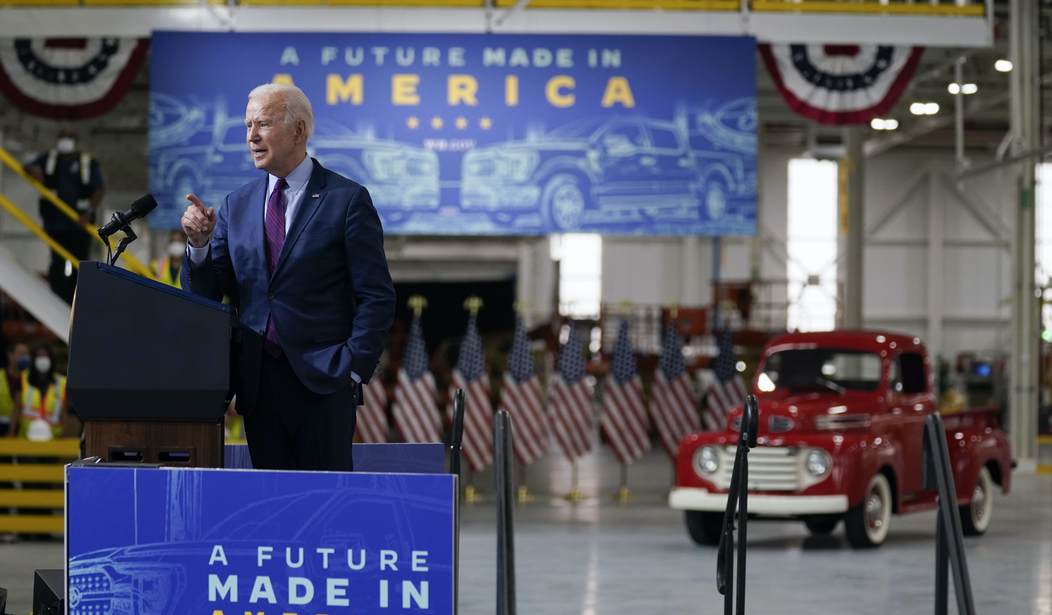As with so many of his other ideas that have been a product of wishful thinking, Joe Biden’s goal that half of all vehicles sold in the U.S. by 2030 be electric vehicles (EVs) seems to be running into the reality of the world as it is, rather than as he wishes it to be. While it is true that 2030 is still over half a decade away, common sense dictates that a long-term trend of EV sales increases would be needed to reach this goal by that time. So far, in 2023, that trend does not appear to be going Biden’s way.
Any search of articles written in late 2022 or early 2023 regarding electric vehicles will likely reveal countless stories about how great sales were going and how the trends hinted at even better EV sales moving forward. Much of this had to do with the amount of money being thrown at EV charging stations and EV tax credits as a result of Biden’s so-called Inflation Reduction Act. However, as we moved further into 2023, something began to change. By the time we got to October, the narrative had become very different from the one in earlier news stories.
A headline on cnbc.com dated October 26, 2023, put into words the problem Biden faces in reaching his 2030 goal. The headline stated: “Ford will postpone about $12 billion in EV investment as buyers become more cautious.” Other news reports have stated that GM is also planning to slow EV production to save the company $1.5 billion over the next year. Even the head of Tesla, a firmly established leader in the EV market, has expressed concerns about the EV market.
This brings up the question, what has changed? Akio Toyoda, the current Chairman and former CEO of Toyota believes that people are waking up to the reality that EVs are not the only way to achieve a clean energy future. Although he does not appear to be anti-EV, Toyoda has been skeptical of the full steam ahead of the adoption of EVs as a sole solution to carbon neutrality. He believes that other technologies, such as hybrid cars and cars powered with hydrogen technology, can be part of the solution.
Recommended
To illustrate the reality to which Toyoda is referring, the dealership inventory for EVs and traditional internal combustion engine (ICE) vehicles were at about 52 days at the beginning of 2023. This means that if the dealers received no additional cars from manufacturers, they could keep selling cars for that number of days before running out. While the supply of ICE vehicles has remained between 52 and 58 days for most of the year, the supply of EVs at the beginning of October was 97 days, slightly down from the peak of 111 days in July. (Why dealers say EV sales have slowed (cnbc.com),
According to industry experts, there are several reasons for the lagging sales of EVs. One major factor is cost. According to a Yahoo Finance article in October, the average price of an EV is $61,488, while the average price for a traditional four-door sedan is about $48,681. Even with a potential $7,500 tax credit, the cost differential remains substantial for the average American. This is especially true if they must finance the car in today’s high-interest rate environment. On top of this, consumers worry about issues such as the range the vehicles can travel without charging, the lack of a nationwide system of charging stations, and the concern for the time it takes to charge an EV. When drivers of traditional cars need gas, they know that it can be found almost anywhere. Consumers know that the same cannot be said for charging EVs. Additionally, consumers have seen reports that the range of EVs can drop by as much as 25% when carrying heavy loads, raising concerns over the lack of charging stations.
Another possible factor in the leveling off of sales is that many highly motivated consumers to buy EVs have already done so. According to Forbes, the first big wave of buyers were high-income households, people motivated by new technology and/or those concerned about the environment. Forbes predicts market growth will be much slower unless many consumer concerns, especially cost, are resolved.
Recent events could make addressing consumer concerns all the more difficult for automakers. First, when they are already subsidizing their losses on EVs with the sale of traditional vehicles, auto manufacturers recently signed a deal with the UAW that will only raise production costs for all vehicles moving forward. In addition, the Texas Public Policy Foundation recently completed a study that considered government subsidies in examining the true cost of EVs. Their conclusion was that “adding the costs of the subsidies to the true cost of fueling an EV would equate to an EV owner paying $17.33 per gallon of gasoline.”
Polls show that most Americans believe that seeking to identify and develop additional energy sources and new technology is good; however, they understand that such efforts should be based on circumstances in the real-world marketplace rather than fantasy. Perhaps the technology for EVs will become competitive in a few years. In the meantime, it is unfortunate that the government has decided to prematurely subsidize EVs to replace traditional vehicles. As illustrated by the Texas Public Policy Foundation study, the actual costs of these subsidies are too great, given our nation’s debt challenges.
Please visit www.joefromtexas.com to learn more.

























Join the conversation as a VIP Member